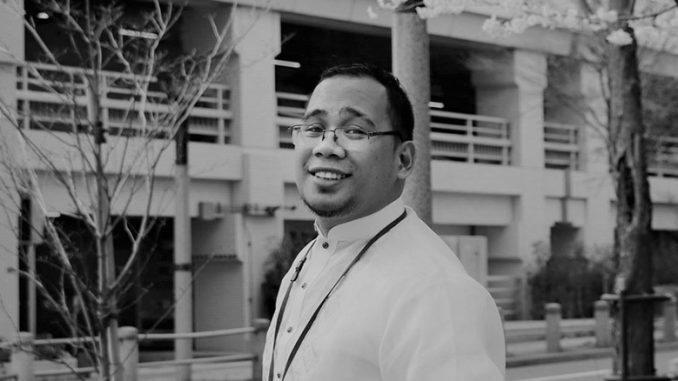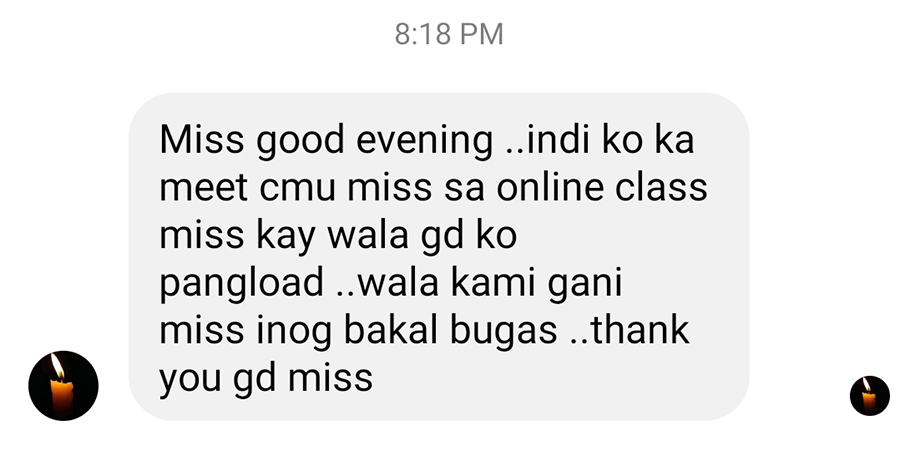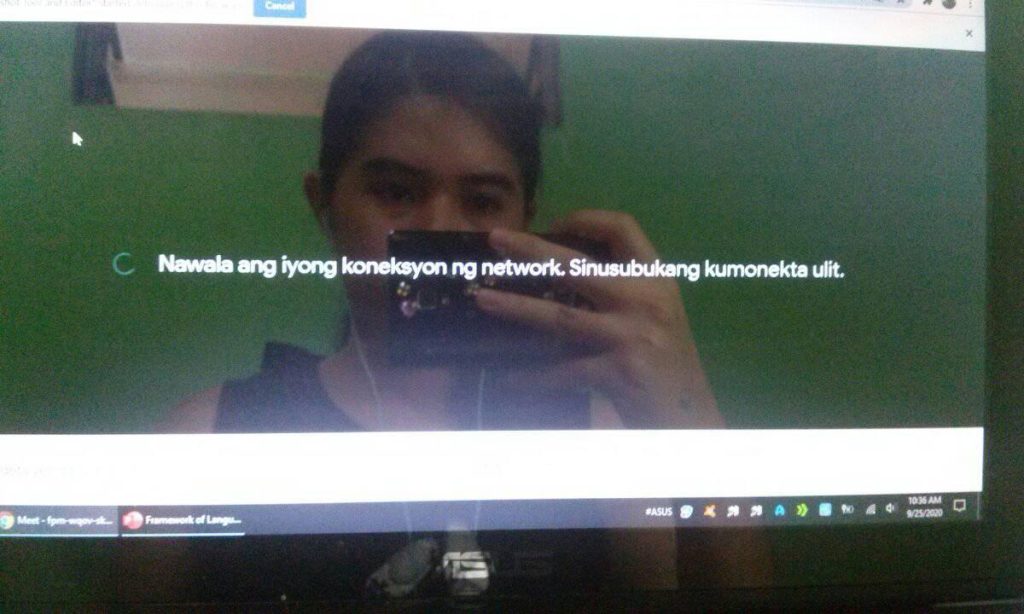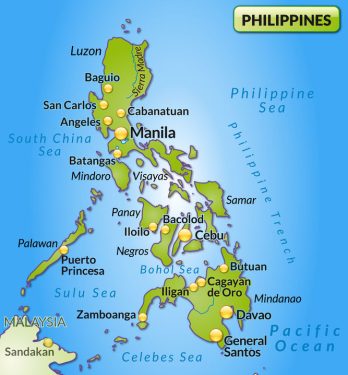
The Philippine government may have been trying to flatten the curve, but COVID-19 cases continue to rise with no abating signs. This Pandemic continues to scourge the Philippines’ economy, where everybody has been affected, especially the daily wage earners who have families to feed and children to send to school.
As a college instructor at Carlos Hilado Memorial State College (CHMSC) in Negros Occidental, Philippines, I have witnessed how my students struggle in this new education format. I also saw how socioeconomic status affects their schooling. The majority of students come from the lower strata of society. Most of them are sons and daughters of Sacada 1 workers with a minimum wage of 315 pesos (approximately USD6.5) per day, and others of contractual workers receiving 395 pesos (approximately USD8) per day. 2 When the Pandemic hit our country, most of their parents became unemployed without any means to support their education, which led to a significant setback on students’ learning and became a burden for students with limited resources, particularly technology and connectivity.
On the other hand, students are affected by this Pandemic; teachers in state universities and colleges experience problems in migrating to the new normal education that causes major adjustments to instruction and shaping the entire landscape of teaching in higher education institutions (HEI). HEIs proposed the Adoptive and Flexible Learning Experience (AFLEX) to combat the problem, where students can opt for synchronous learning. If they have internet connectivity, they will have online classes. Asynchronous learning is for those with limited internet capability to use learning modules. However, despite the effort to stop the gap of learning, it is still a band-aid solution.
Killing the Spirit: How Education During Pandemic Becomes a Problem Itself
“Sir, sorry indi ko anay magsulod sa online class ta kag malate ko pasa sang requirements kay ga timbang pa ko sa balay sang tawo para ma suportahan pamilya ko kay wala ubra kaginikanan ko.” (Sir, I am sorry. I can’t attend our online class and I will pass my requirements late because I work as a house help to support my family since my parents are unemployed).

The preceding sentence is why students have a hard time focusing on school because they take jobs to help their parents. Quarantines have paralyzed businesses for the past months, and laborers are experiencing “tiempo muerto. 3 “Since the opening of classes, particularly in our college last August, the infliction of the dead season where no work is available in the cane fields and the closing of establishments contributed to the students’ demise. Fortunately, students didn’t pay for their matriculation; they only paid for the insurance fee worth 100 pesos (approximately USD2).
However, despite the absence of matriculation and tuition fees, students still have a hard time learning due to their limited internet connection, limitation of their devices for online learning, and prepaid load sustainability. One student complained, “Sir, malakat ko sa computeran sa banwa para makapass sang akon output kay ang akon cellphone indi kasarang sang applications nga kinahanglan i-access.” (Sir, I will go to an internet café in the town to pass my output since my cellphone doesn’t have the capacity for the applications required for access.”
My students are referring to Google Classroom® and other Microsoft Office® software. This quote comes from another student, “Sir, karon lang ko anay mapasa sa gab-e ha kay nahulam ko lang ang cellphone sang tita ko kay hi-tech iya cellphone.” (Sir, I will pass my output later at night because I am borrowing my aunt’s cellphone because it is high tech compared to mine). My student is referring to her basic cellphone that is only capable of calls and texts.
The online teaching platform, such as video conferencing, attempts to replicate face-to-face classes inside the classroom. However, this virtual teaching mode using Google Meet® or Zoom® tends to be costly for students dependent on prepaid data load. Online classes consume a considerable amount of data due to the hours of lectures, the number of attendees in the class, and watching supplemental videos on YouTube. The 100 pesos budget to load data, which is supposed to be good for one week, lasts only three days due to excessive online classes use. Despite connectivity and limited devices, some students still didn’t choose printed modules because most of their teachers require them to submit their activities online. Such circumstances affect their learning because all they do is to comply with the exercises given to them.

I asked one of my students what their thoughts on education today are, and she answered, “Sir, feeling ko wala learning, ga pasa kami for the sake of completion lang kag wala kami may nabal-a guid. Wala namon gin basa ang module ga diretso lang kami answer sang activities kag nakulbaan kami mabilin“. (Sir, I feel that there is no learning this time. We pass our requirements for the sake of completion, but we don’t learn anything from it. We don’t read our modules; we answer the activities directly because we are afraid to be left behind).
Some of them stopped while some got depressed because their family can’t support their education. I still remember a father inside the mall who asked me, “Sir diin pwede ka bakal laptop nga ga balor P5000.00? Para ni sa akon bata nga ma online class“. (Sir, where can I buy a laptop worth P5000.00? This is for my daughter for her online class). He showed me his cold cash. I saw his hands. They manifest hard labor, and he was hoping his hard-earned money will bring home a new laptop for his daughter but sadly, even a laptop with low specifications is worth at least P15,000.
Based on my experience, I conclude that society has been forcing education amidst the Pandemic. The vulnerable in this scenario are students belong in the lowest strata of our community. Teaching in the time of a pandemic is a pandemic itself.

Struggle and Power Politics in the Academe
One of the reasons students and teachers, especially in state universities and colleges, suffer is power politics. Appointed administrators belong in the same circle or are allies of the university or college president. Thus, there is no room for dissenters when it comes to policymaking. This centralization of decision-making brings student problems to teachers. Such poor decision-making and indecisiveness draw confusion and distress. Among these is the forced opening of classes without enough preparation for the modules, demographic mapping of students who have problems of internet connectivity, faculty support in work from home settings, and one mode of learning for the benefit of all.
Some lower management, who are supposed to voice out their colleagues’ concerns, are afraid to speak since they will receive drawbacks from the middle and upper management, resulting in a snowballing effect from faculty to students. The attitude of middle and lower management can be referred to as Hannah Arendt’s work, the banality of evil. 4
Deidre Lauren Mahony (2018) defined it as “inability to think, namely, to think from the standpoint of somebody else.” They leave their colleagues behind. They are motivated by their agenda, such as social and financial success. Thus, everything falls apart. Their superiors force college teachers to submit the requirements and dismiss dialogues between the administrators and the faculty. Despite the majority foreseeing the problem of hastily made modules and premature opening of classes bringing questions and confusion to students, administrators pushed through with it. As of now, problems in students’ learning and teachers’ difficulty in teaching continue to surface.
Poor leadership and planning have caused an avalanche of problems. Some students have no access to stable online connections and are too far away to receive modules. The teachers suffer from module preparation to hand in a finished product. As I have said, this practice creates a ripple effect from teachers to students; to pressure the teachers is also to pressure them. The situation has been an issue of students against their teachers; however, teachers cannot complain because upper management mandated this. Since they are motivated by their private concerns, they always think of their particular agenda and never the collective. The academe today is problematic because of this. Sycophants of the authority destroy the public agenda by prioritizing private agenda.

Reversing the Reversal: Establishing the Voice of the Majority
The standard type of leadership in every good government system is democratic, which is participative. However, one cannot deny that participation is possible for the person’s closest circle in authority only. Therefore, whatever decision the body makes should follow the will of the authority. This scenario is a classic case of top-down management that impels the teachers at the grassroots. Reversing that kind of leadership will lessen the perplexity and avoid future problems in integrating new pedagogy into the curriculum.
This management style is lacking mostly in the academe; even the graduates of the Doctor of Education major in Instructional Leadership and Management fail to incorporate this style with their colleagues. Many professors with graduate degrees fail in leadership because their appointment is to secure power.
Establishing the voice of the majority is similar to the bottom-up management style. However, unlike bottom-up management, employees are invited to participate in goal setting – sometimes only with feedback, sometimes when they have a stake in the decision. In establishing the majority’s voice, all teachers regarded as front liners and implementors of this lesson must be given a voice and must be the priority. Since they are the ones who are involved in the process, they are the ones that administrators must heed, empowering rather than suppressing.
The practice of establishing the voice of the majority reverberates in the Central Philippine State University approach. They listened to their teachers involved in module making and scheduled their opening of classes on October 5 to prepare their teachers for proper implementation of their asynchronous teaching or modular methods. They can map their students who live nearest the campus and coordinate with their respective barangays to release and pick up modules. Through this, teachers will feel empowered, and the stress of students to complete their output lessens.
We must feel the humanity in education despite the problems that students and teachers experience in the Pandemic. Hence, reversing the reversal will minimize the endless meetings without a proper resolution and chronic seminar-workshops that don’t contribute to development, which wasted the resources allotted for faculty development.
Listening to the majority’s voice will help the administration revisit their decisions and align the institutional objectives to teachers’ and students’ needs. It is not a definitive solution to the problems we face today, but it is more humane and compelling than we have practiced before. It is a way of humanizing and empowering them, both students and teachers. Hence, the purpose of education must be to emancipate oppressed people by empowering them and enabling them to transform their living conditions.
Sensei M. Adorador
Sensei M. Adorador is an Instructor at Carlos Hilado Memorial State College-Talisay City, Negros Occidental and University of the Philippines- Visayas. His research interests include Philosophy of Education, Sociology of Education, and conflict and reconciliation, particularly the indigenous people and Sacadas of Negros Occidental. He is a member of the Congress of Teachers and Educators for Nationalism and Democracy (CONTEND).
Notes:
- Sacada refers to sugarcane workers ↩
- According to the latest National Wages and Productivity Commission of Department of Labor and Employment. https://nwpc.dole.gov.ph/regionandwages/region-vi-western-visayas/ ↩
- Tiempo muerto translates as dead season. August is considered as dead season. Sacadas explained that it is the six-month gap between planting and harvesting sugarcanes when there is no available work in the cane fields ↩
- Eichmann in Jerusalem: A Report on the Banality of Evil (1963) ↩
